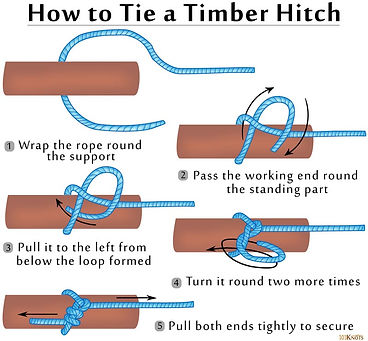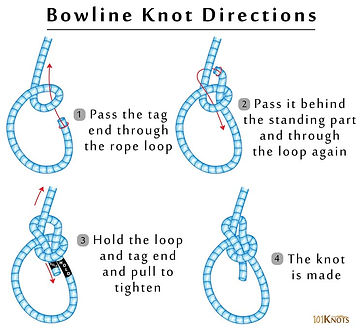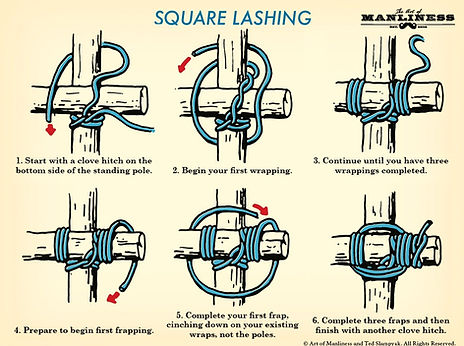Knots
From the Scout rank all the way through Eagle, there is one thing every boy scout must know. Knots, Knots and Knots!
In Troop 97, your knowledge of knots will constantly be tested, and you will be expected to remember knots you learn at each rank advancement. These knots will form the foundation for other scouting skills, such as lashings.
Square Knot
The square knot can join 2 ropes of the same size. It is the first knot we learn to make with our shoelaces. It looks like a bow and is hugely unreliable. Its breaking strength is only 45% of the line strength. This leads surgeons to add an extra turn to the first half knot. The simple and ancient binding knot is also known by the names Hercules, Herakles, flat, and reef knots. It helps to secure a line or rope around an object. It creates unique designs of jewelry.

Two Half-Hitch
Also known by the names double half hitch and clove hitch around itself, this knot is an overhand knot followed by a half hitch. The Ashley Book of Knots states that Steel gave it its name in 1794. It can be tied around a ring, dock, post, tree, etc. It is commonly used in mooring and general utility. It is helpful in moving large objects, for example, logs.
.jpg)

Taut-line
It is a non-slipping, adjustable loop knot hitch based on the rolling hitch. It is also known by the names adjustable hitch, tent-line hitch, tent hitch and rigger’s hitch. It slides freely but jams under load making line adjustments simple. You could reverse the direction of the half hitch made in step 3 of the below diagram to avoid twisting the knot.

Timber Hitch
The timber hitch is used to secure a rope round a post or any cylindrical object. It is also known as Bowyer’s Knot owing to its use in attaching the end of the bowstring to a longbow.
Clove Hitch
It is considered to be one of the most important knots alongside the sheet bend and bowline. Also known as a double hitch, it is simply 2 back to back half hitches around a cylindrical object such as a tree, ax or a post. It causes an efficiency loss of approximately 40%. The quick release knot can also be tied with webbing. It can be an interesting forest school activity.

Bowline
The bowline (pronunciation “boh-lin”) is a knot that can itself be tied at the middle of a rope making a fixed, secure loop at the end of the line. It retains about 60% of the line strength and has a knot efficiency of 77%. You can learn this basic knot taught at ranger schools by the aid of the below printable diagram with instructions.


Square Lashing
Square Lashing Knots can be used to make a rectangular frame. Many applications have been described including: making support frames; when two trees are close enough, a table can be supported by a pair of poles or branches lashed horizontally either side of the trees; a fence can be constructed by driving poles into the ground and then joining them with bars attached with Square Lashing Knots; and a raft can be created by lashing bamboo poles across each other.

Diagonal Lashing
The Diagonal Lashing Knot (ABOK # 2115, p 343.) is used to lash two spars together. Unlike the Square lashing which works for right angle crossings, the diagonal lashing secures poles crossing each other at a variety of angles.


